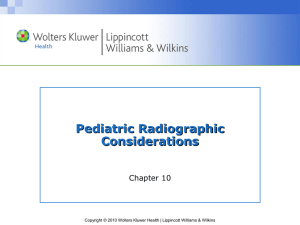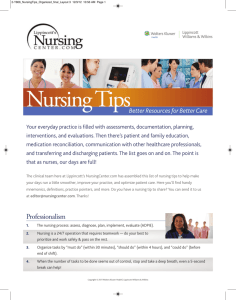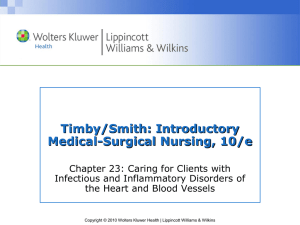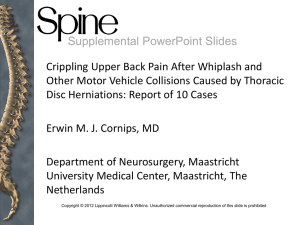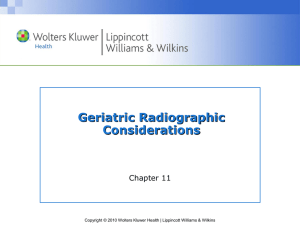Chapter 2
advertisement
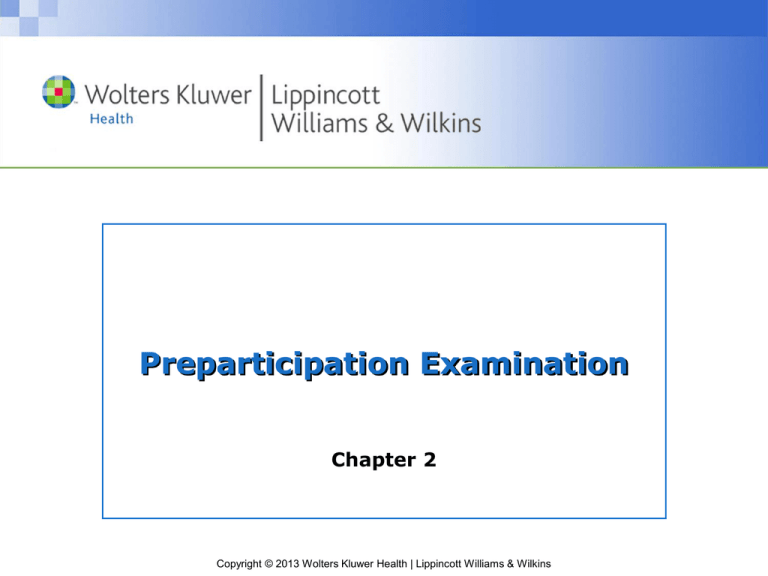
Preparticipation Examination Chapter 2 Copyright © 2013 Wolters Kluwer Health | Lippincott Williams & Wilkins Preparticipation Exam (PPE) • Objective – to ensure the health and safety of a physically active individual • Focus – dependent on: – Specific age group – Intended sport/activity Copyright © 2013 Wolters Kluwer Health | Lippincott Williams & Wilkins Setting Up the PPE • Exam format – Primary care physician • Advantages: familiarity, relationship, privacy • Disadvantages: $$, time commitment of M.D. – Group or station format • Advantages: number of professionals involved, less $$, time efficient • Disadvantages: organization demands, decreased privacy, follow-up difficulty, communication problems Copyright © 2013 Wolters Kluwer Health | Lippincott Williams & Wilkins Setting Up the PPE (cont.) • Timing of the exam – 6 weeks prior – permits time to: • Correct minor problems • Refer medical problems to a specialist • Frequency – Entry level exam followed by a limited annual re-evaluation – Entry level exam at each level of participation Copyright © 2013 Wolters Kluwer Health | Lippincott Williams & Wilkins Medical History • Comprehensive history – General medical – Orthopedic – Supplemental form for females Copyright © 2013 Wolters Kluwer Health | Lippincott Williams & Wilkins Physical Examination physical examination is not intended to be all-encompassing … it is intended to focus on body systems of most concern relative to participant’s sport/activity • Vital signs – Establish baseline physiologic parameters and vital statistics • General medical problems – Past surgery or hospitalizations – Medications (including OTC) – Use of alcohol, tobacco, ergogenic aids Copyright © 2013 Wolters Kluwer Health | Lippincott Williams & Wilkins Physical Examination (cont.) • Cardiovascular exam – Auscultation of heart sounds – Check for cardiac abnormalities – History of loss of consciousness, syncope, dizziness, shortness of breath, heart palpitations, and chest pain during or after examination • Pulmonary exam – Auscultate for breath sounds – History of coughing or breathing difficulty – Ear, nose, and mouth may also be checked Copyright © 2013 Wolters Kluwer Health | Lippincott Williams & Wilkins Physical Examination (cont.) • Musculoskeletal exam – History of previous injury, including: • Nature of injury • When it occurred • Who evaluated it • Duration of treatment and rehab • Use of special protective equipment – Physical exam (refer to Field Strategy 2.3) • Neurologic exam – History of past head injury, loss of consciousness, amnesia, or seizures – Exam: pupillary examination and reaction to light, cranial nerve assessment, motor-sensory exam, deep tendon reflex testing Copyright © 2013 Wolters Kluwer Health | Lippincott Williams & Wilkins Physical Examination (cont.) • Eye examination – Visual acuity – Peripheral vision and depth perception – Nystagmus – Pupil size • Dental examination – Determine number of teeth and last visit to dentist – Exam: gum condition and presence of cavities, dental appliances Copyright © 2013 Wolters Kluwer Health | Lippincott Williams & Wilkins Physical Examination (cont.) • Gastrointestinal exam – Digestive system, eating habits, and nutrition – History of heartburn, indigestion, diarrhea, or constipation • Genitourinary exam – Kidney and genitourinary organs – Females – menstrual history, gynecologic symptoms Copyright © 2013 Wolters Kluwer Health | Lippincott Williams & Wilkins Physical Examination (cont.) • Dermatologic exam – Identify contagious lesions, skin infections – Other lesions (e.g., warts, acne) • Exam for heat disorders – Environment related – history of cramping, syncope, exhaustion, or heat stroke – Use of medications • Laboratory tests – Not recommended by AAP – Required by some states Copyright © 2013 Wolters Kluwer Health | Lippincott Williams & Wilkins Physical Fitness Profile • Identifies weaknesses that may: – Hinder athletic performance or – Predispose the athlete to injury • Establishes a baseline of data in the event an injury does occur Copyright © 2013 Wolters Kluwer Health | Lippincott Williams & Wilkins Body Composition and Anthropometry • Body composition – Fat vs. lean tissue – More reliable for determining appropriate weight – Measures: hydrostatic weighting, skinfold measurements – Athletes—12–17% body fat • Anthropometry – Determines individuals’ body type Copyright © 2013 Wolters Kluwer Health | Lippincott Williams & Wilkins Maturation and Growth • Growth spurts may play a role in certain injuries • Tanner scale — physical maturation measurement Copyright © 2013 Wolters Kluwer Health | Lippincott Williams & Wilkins Flexibility • The total ROM that occurs pain-free in each of the planes of motion • Measured with a goniometer, flexometer, or tape measure • Hypermobility vs. hypomobility Copyright © 2013 Wolters Kluwer Health | Lippincott Williams & Wilkins Strength, Power, & Speed • Strength – Ability to produce force in one maximal resistance – Measures can involve isometric, isotonic, or isokinetic testing • Power – Ability to produce force in a given time – Measures include: throwing a medicine ball, vertical jump and reach, single- or two-legged hop for distance, and stair climbing • Speed – Ability to move body mass over time – Can be assessed by timed sprints Copyright © 2013 Wolters Kluwer Health | Lippincott Williams & Wilkins Agility, Balance, and Reaction Time • Agility – Ability to change directions rapidly when moving at a high rate of speed • Balance – Body’s coordinated neuromuscular response to maintain a defined position of equilibrium in response to changing visual, tactile, or kinesthetic stimuli • Reaction time – Ability to respond to a stimulus Copyright © 2013 Wolters Kluwer Health | Lippincott Williams & Wilkins Cardiovascular Endurance • Ability to sustain submaximal exercise over an extended period Copyright © 2013 Wolters Kluwer Health | Lippincott Williams & Wilkins Clearance for Participation • Physician determines the level of participation 1. Will the condition increase the risk of injury to the athlete or to other participants? 2. Can participation be allowed if medication, rehabilitation, or protective bracing or padding is used? If so, can limited participation be allowed in the interim? 3. If clearance is denied for a particular sport, are there other sports or activities in which the individual can safely participate? Copyright © 2013 Wolters Kluwer Health | Lippincott Williams & Wilkins Clearance for Participation (cont.) • Rehabilitation Act and Americans with Disabilities Act • Most physicians base their recommendations on the American Academy of Pediatrics Committee on Sports Medicine guidelines Copyright © 2013 Wolters Kluwer Health | Lippincott Williams & Wilkins



